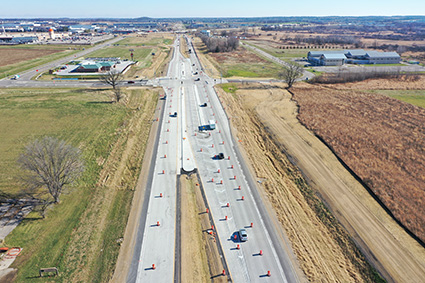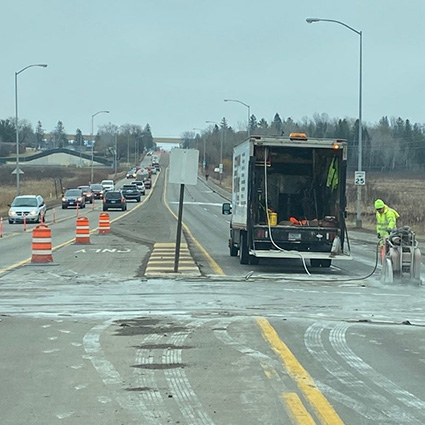Contractors can repair or rebuild a road more quickly and less expensively if the road is completely closed to traffic. However, this is usually not feasible. The road may be the only way to access businesses, or there may not be an adequate detour.
When front access for businesses is critical, WisDOT accommodates traffic in two ways:
-
Under construction but open to traffic. This alternative is used on high-volume highways like the Interstate or multilane roads where one lane can be rebuilt while traffic is restricted on the other. This option is also used for resurfacing low-volume roads without suitable detours, where the project can be done one lane at a time with signs or flagging crews.
-
Road closed to through traffic, open to local traffic. "Through traffic" refers to vehicles that do not have an origin or destination inside the work zone.
Detour signs direct through traffic to an alternate route around the work zone. WisDOT strives to keep the detour length to a minimum, making certain the new route is in good condition and capable of safely handling heavy traffic, including trucks. It’s important that the detour is easy to navigate.
Through traffic drivers who choose to use closed roads are subject to traffic tickets.
Local traffic
"Local traffic" refers to vehicles with a destination inside the work zone. This includes but is not limited to residents, customers, business owners, delivery trucks, emergency vehicles and school buses.
When someone needs access in a work zone, we ask them to minimize their use of the road. Drivers can minimize their use of roads in work zones by using side roads that intersect close to the destination.
WisDOT restricts local traffic because work zones are filled with trucks, earthmovers and other equipment— all moving in different directions. When local traffic is heavy, contractors hire flagging crews to direct traffic and prevent collisions between drivers' vehicles and construction equipment. The heavier the traffic, the greater the danger of collisions, delays and increased costs.
While the contractor is required to maintain a safe and adequate path for local traffic the roadway may be bumpy, dusty or muddy. Occasionally, contractors provide a temporary gravel path adjacent to construction. Sometimes, roads are temporarily closed to all traffic and only maintained for emergency vehicles. Roads can be closed for a few hours or a few days. WisDOT works hard to keep road closures as short as possible. Important deliveries can be scheduled with the contractor and the project manager.
Installing new pavement when traffic is present
Concrete pavement requires a cure time of three to seven days, depending on the amount of cement in the mixture. If access is given to businesses during this time period, it is necessary to provide a "gap" in the pavement. Such gaps require workers to stop operations, move the paving machine ahead, and restart the entire operation. Workers must fill the gaps at a later date.
Pavement gaps delay project completion, compromise ride quality and increase costs. The paving contractor may approach businesses to help reduce or eliminate the need for paving gaps. For example, businesses may be asked to share gaps. Without paving gaps, contractors can pave nearly a mile a day. With gaps, production can be cut in half or more. This means the project will take longer to complete. WisDOT’s goal is to complete the project as quickly as possible at a reasonable cost.
Staying open during construction 
There are many communities where businesses operated successfully during construction that closed their main street and required customers to use back streets and entrances.
- One city aggressively promoted businesses and encouraged shoppers to park on nearby streets and walk.
- Some businesses have spruced up their back entrances and erected colorful signs to direct shoppers to off–street parking.
- In one southeastern community, the local newspaper printed maps showing how to get around with the detour. Other newspapers have mapped alternate routes.
- Additionally, businesses have erected signs for local shoppers while trucks and through traffic followed the official detour route.
Learn about temporary business signage.